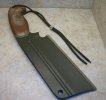Fascinating conversation gentlemen, thank you. I've often been told to put blades in cold and let them heat up with the kiln, but I think I understand how that could be a problem, now. I'm not qualified to ask the complex questions, so I'll ask a simple (but multi-part) one:
A) after allowing the kiln itself to reach temp and stabilize, how long does it take for a room-temperature blade to reach the desired austenizing temp? If I understand this right, it's important to let the whole piece come up to temp, then time the "soak", yes? (FWIW I'm talking about deep-hardening, moderate-to-high-alloy steels, so I'm presuming this is fairly important)
B) Would preheating the steel to, say, 400F in a separate oven while the kiln ramps up and stabilizes help, or just be a waste of electricity?
C) Again, assuming we're dealing with a kiln that's as accurate and stable as we can get it, what effect does putting in 6 blades rather than 1 at a time have? Does the extra mass help keep things even, or would I get measurably different results on the blades closest to the walls/elements, compared to the one in the center of the kiln?
I have a 14" 110V Paragon, if that makes a difference.

